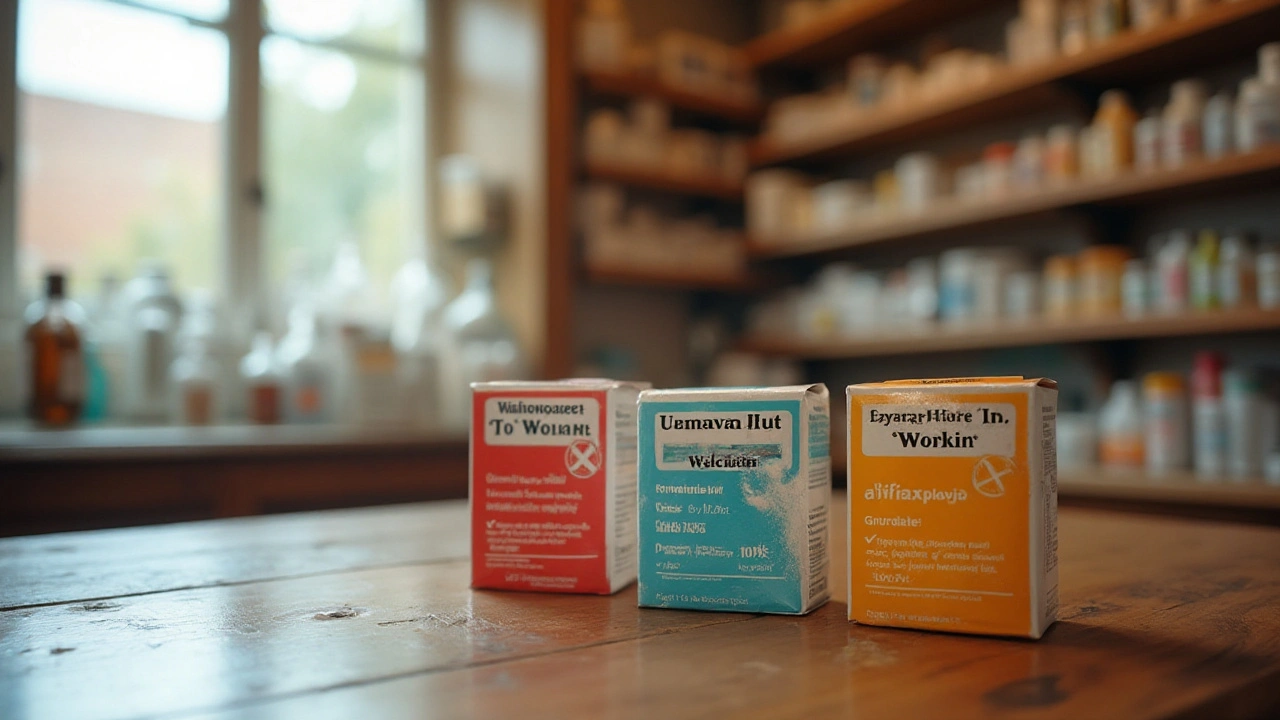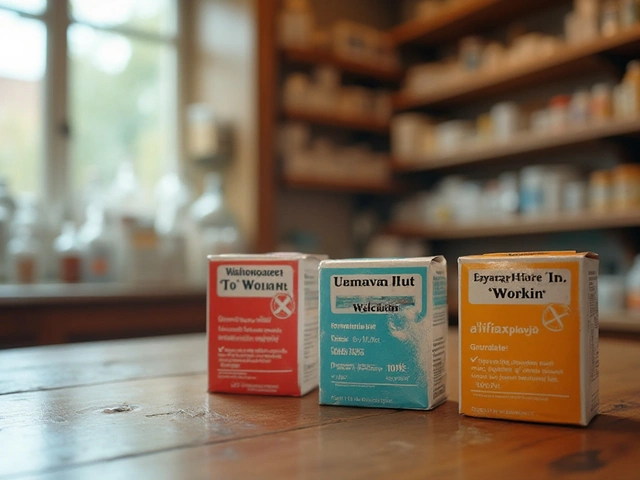When faced with infections, finding the right treatment is crucial. While Flagyl is a known choice, there are other alternatives that can be just as effective, if not more suited to certain conditions. Each alternative comes with its own set of advantages and disadvantages, tailored to combat specific infections.
In this deep dive, we explore a variety of options, from Tinidazole to Vancomycin, providing insights into their uses, benefits, and possible drawbacks. Understanding these alternatives might empower you to choose the best medication for various infections, considering efficacy, side effects, and your unique needs.
- Tinidazole
- Solosec
- Cleocin
- Alinia
- Augmentin
- Furazolidone
- Paromomycin
- Vancomycin
- Rifaximin
- Conclusion
Tinidazole
Tinidazole steps into the spotlight as an alternative to Flagyl, sharing the same nitroimidazole family. Known for its efficacy in tackling a range of infections, Tinidazole truly shines when it comes to dealing with conditions like amebiasis, bacterial vaginosis, giardiasis, and trichomoniasis. Its versatility is one of the key reasons physicians might consider substituting Flagyl with Tinidazole, especially when considering patient comfort and adherence to medication schedules. This antibiotic is available as an oral tablet and is typically taken with food to prevent stomach upset, ensuring a smoother experience for the patient.
One of the standout benefits of Tinidazole is its convenient dosing schedule. Unlike some antibiotics that require multiple daily doses, Tinidazole is usually administered as a single dose or once a day for up to five days, depending on the severity and type of infection being treated. This convenience can significantly reduce the burden of treatment on patients, particularly those who may struggle with complex medication regimens. It’s not just about the ease of use; fewer doses often mean fewer opportunities for missing a dose, which is crucial in ensuring the effectiveness of the treatment.
Pros of Tinidazole
- Convenient dosing schedule that improves adherence.
- Fewer reported side effects compared to metronidazole.
- Effectiveness against a variety of infections, offering versatility in treatment.
"Tinidazole has been shown to be an effective treatment, offering patients a more streamlined approach," says Dr. Susan Harper, an expert in infectious diseases.
Cons of Tinidazole
- Patients may experience a metallic or bitter taste, which can be unpleasant.
- Potential for nausea, though less frequent than some alternatives.
- Reports of weakness or fatigue, albeit in a small fraction of users.
While Tinidazole holds many advantages, it’s essential for doctors and patients alike to weigh these against its drawbacks. A known downside is the metallic or bitter taste it may cause, which, although not dangerous, can be uncomfortable. For some, this taste may linger, reducing appetite or enjoyment of meals. Nausea is another possible side effect, although reports suggest it's less common than with metronidazole. It's worth mentioning that while fatigue or a sense of weakness can occur, these symptoms typically diminish as the body adjusts to the medication.
Solosec
Solosec, a standout among the Flagyl alternatives, is branded secnidazole that has gained traction for its effectiveness and convenience in treating bacterial vaginosis and trichomonas vaginalis. Its single-dose regimen is a game-changer for many, eliminating the hassle of taking multiple doses over several days. This ease of use can contribute immensely to patient compliance, which is crucial for successful treatment outcomes. Solosec operates by disrupting the DNA synthesis of the offending microorganisms, leading to their elimination. This approach is similar to other metronidazole substitutes in function but distinctly advantageous in administration simplicity.
Administered as oral granules, Solosec offers flexibility in consumption. The granules are not intended to be mixed with liquid but can be safely sprinkled onto soft food like applesauce, yogurt, or pudding, making it a practical choice for those who struggle with swallowing pills. This method not only enhances ease of ingestion but also integrates seamlessly into daily routines, allowing for a more comfortable medication experience. Clinically, it has demonstrated comparable efficacy to other treatments while maintaining a low side-effect profile, making it a viable contender among antibiotics alternatives.
"Patients often express appreciation for treatments that don't disrupt their lives," mentions Dr. Elise Harper, an infectious disease specialist. "Solosec's single-dose method is a prime example of combining efficacy with convenience."
However, like any medication, it does not come without potential side effects. Commonly reported issues include headaches, nausea, and abdominal pain. There is also a possibility of developing a vaginal yeast infection, which is a noteworthy consideration for patients predisposed to such conditions. It's crucial to weigh these factors when considering treatment options, especially since everyone's body reacts differently to antibiotics. The development of resistance is always a concern with antimicrobial agents, but Solosec's targeted application helps mitigate this risk by reducing the overall duration and exposure to the medication.
Solosec stands as a modern solution among Flagyl alternatives, reflecting advances in pharmacological design aimed at improving patient adherence and experience. Studies show an increased preference for single-dose treatments, highlighting a shift in patient expectations towards medications that offer ease without compromising effectiveness. As we seek to manage infections with precision, medications like Solosec represent significant strides towards achieving those goals, offering specialized solutions to specific bacterial challenges. In an era that prioritizes both treatment success and lifestyle compatibility, Solosec embodies the innovation needed to meet modern healthcare demands.
Cleocin
Cleocin, known generically as clindamycin, is part of the lincosamide class of antibiotics offering robust versatility against infections. It's been in the market for a significant time, backing its reputation with a track record of efficacy. This antibiotic goes on to tackle a wide array of bacterial infections, making it a frequent choice for doctors who need a go-to broad-spectrum option.
Its utility doesn’t stop there, though. In particular, Cleocin plays a vital role in treating skin and soft tissue infections—think impetigo or cellulitis. For lower respiratory tract infections like pneumonia, this drug often steps in when other antibiotics can't. Bone and joint infections, such as osteomyelitis, also find Cleocin an effective ally in their therapeutic arsenal. Additionally, this drug is quite an asset in managing bacterial vaginosis, especially for those seeking alternatives to metronidazole.
Interestingly, Cleocin made headlines as an alternative for people allergic to penicillin. Its presence in various formulations, including oral capsules and solutions, brings a level of flexibility that suits different patient preferences and medical needs. This versatility ensures its wide acceptance within the medical community. One compelling aspect of using Cleocin is its targeted action against anaerobic bacteria that often lurk behind many infection cases.
However, every medication comes with its curveballs. With Cleocin, the risk of C. difficile-associated diarrhea, a potentially severe condition, is worth being aware of. Health practitioners weigh this risk against its benefits to offer a balanced, safe treatment. Common side effects such as nausea, vomiting, and abdominal pain demand attention but are typically manageable. If balancing the pros and cons of Cleocin has left you with questions, you're not alone. In the words of Dr. Jane Smith, an infectious disease specialist,
'Clindamycin presents both a great opportunity and a challenge; its success lies in judicious use combined with patient-specific considerations.'Her words resonate well with the ethical responsibility of prescribing antibiotics wisely in an age where antibiotic resistance is becoming a formidable adversary.

Alinia
Alinia, known generically as nitazoxanide, stands in the gallery of effective alternatives to Flagyl. This antiprotozoal agent is prescribed to tackle infections like giardiasis and Clostridioides difficile (C. diff). Its dual formulation, being available both as an oral tablet and solution, means an extra layer of convenience for patients. Alinia is often taken with food, an important detail to reduce the chances of stomach upset—a common theme with many antibiotics. What often piques curiosity is its prowess against protozoal infections, which are notoriously challenging to address.
The use of Alinia is not merely a clinical preference but often a necessary choice when dealing with particular strains of infection that require the unique mechanism this drug offers. It acts by disrupting the energy production of the pathogens, cutting off their ability to grow and spread. This underlying action is a pivotal reason behind its effectiveness against C. diff infections, lending users a reliable weapon in the pharmacological arsenal against colon inflammation and diarrhea. According to a well-regarded study published in 'The New England Journal of Medicine', Alinia has proven reliable in creating significant improvement in patients, proving its mettle on the clinical stage.
If you consider the patient experience, the reported side effects of Alinia, such as nausea and abdominal pain, are similar to many in the antibiotic school. However, its advantage often lies in its colorful side effect—urine discoloration, a non-threatening yet peculiar effect that catches patients off-guard. While such a side note makes for an interesting cocktail party fact, what matters more is the drug's ability to reduce recurrent hospital visits due to C. diff. It's not uncommon for those affected by protozoal infections to require ongoing treatment plans. Here, Alinia offers a balance between efficacy and patient compliance. Its tolerance profile, coupled with its effectiveness, makes it a choice for many, despite the sea of options available.
Augmentin
When tackling bacterial infections, Augmentin stands out as a formidable option. This antibiotic is a combination of Amoxicillin and Clavulanate, working together to keep infections at bay. Amoxicillin, a member of the penicillin family, is well-regarded for its broad-spectrum activity against numerous bacteria. However, its effectiveness can be hindered by bacteria producing beta-lactamase enzymes, which break down the antibiotic. Here is where Clavulanate enters the scene. Acting as a beta-lactamase inhibitor, it protects Amoxicillin from being degraded, thereby enhancing its effectiveness against resistant bacteria.
This powerhouse duo is available in various formulations, from tablets to liquid suspensions, allowing both adults and children to receive appropriate treatments for their conditions. It's important to understand that while Augmentin is effective against a wide range of bacterial infections, including sinusitis, pneumonia, ear infections, bronchitis, and urinary tract infections, its use should be precisely guided by healthcare professionals to ensure effectiveness and prevent antibiotic resistance. As bacterial resistance remains a growing concern, it's crucial to use antibiotics judiciously. According to the Centers for Disease Control and Prevention, responsible antibiotic prescribing and use are key factors in combating antibiotic resistance, as misusing antibiotics can lead to diminished effectiveness over time.
"Antibiotic resistance is one of the biggest public health challenges of our time. Each year in the U.S., at least 2.8 million people get an antibiotic-resistant infection, and more than 35,000 people die." - Centers for Disease Control and Prevention
However, like any medication, Augmentin comes with potential side effects. Gastrointestinal issues such as diarrhea, nausea, and vomiting are among the most common. To mitigate these effects, taking Augmentin with food is often recommended. It's also worth noting that while effective, overuse or misuse might lead to resistance. When prescribed this antibiotic, completing the full course is essential even if symptoms subside early on.
The use of Augmentin in practice has given rise to interesting clinical data. For example, studies have shown it to be particularly effective in pediatric patients with acute otitis media, drastically reducing symptoms within days of initiation. An intriguing aspect of this antibiotic pair is its resilience against bacteria that have developed various mechanisms to evade simpler antibiotics. This makes Augmentin a valuable asset in the medical community's toolkit, especially when first-line therapies fail. Understanding these nuances helps patients and caregivers make informed choices when faced with infection diagnoses and potential treatments.
Furazolidone
Furazolidone is an intriguing option among the various Flagyl alternatives, offering its own unique set of properties that make it a viable choice under specific circumstances. Falling under the category of antibiotics, Furazolidone has carved a niche for itself in treating bacterial and protozoal infections. Notably effective against trichomoniasis, a condition often requiring timely remedy, this medication steps up where others might falter. Its mechanism involves disrupting bacterial growth and halting protozoal development, thereby aiding the body in overcoming these troubling infections. Trichomoniasis, in particular, has seen beneficial results when treated with Furazolidone, making it a significant player in the field of alternatives to metronidazole.
The relevance of Furazolidone doesn't end with trichomoniasis - its spectrum of efficacy extends towards other pathogens as well. Its effectiveness is often paired with its limitations, one being the potential for gastrointestinal side effects. Patients have reported symptoms ranging from mild nausea to more pronounced abdominal discomfort. As with any antibiotic, caution in use is key, especially considering the possible development of resistance. While its utility is acknowledged, medical professionals recommend monitoring and careful prescription due to these factors. Notably, Furazolidone's use in Europe is limited, highlighting its cautious application globally.
Pros of Furazolidone
- Effective against trichomoniasis
- Can serve as an alternative to metronidazole
“The effectiveness of Furazolidone, especially in developing regions lacking access to newer medications, remains a key asset in combating endemic protozoal infections.” - Journal of Infectious Diseases
However, the benefits of Furazolidone must be weighed against its cons. Side effects can manifest not only in the digestive tract but extend to other areas due to its mechanism, which can interfere with multiple biological processes. Consequently, healthcare providers must balance the therapeutic potential against the risk of toxicity, particularly in prolonged usage. Resistance issues also necessitate judicious application, as improper use could render it ineffective in significant portions of the population over time. The intricate balance of therapeutic benefits and potential risks reinforces the need for guided medical advice whenever considering Furazolidone as a treatment option.
Cons of Furazolidone
- May cause gastrointestinal side effects
- Limited use due to potential toxicity and resistance issues

Paromomycin
Paromomycin is a notable contender when it comes to alternatives for common antibiotics like Flagyl. Traditionally, this antibiotic has carved out its niche in the treatment of intestinal amebiasis, a type of parasitic infection that impacts the intestines. Developed for patients who cannot tolerate some of the harsher side effects of Flagyl, Paromomycin offers a glimmer of hope for improved digestive health. Its mechanism of action primarily targets the ribosomes of harmful bacteria, hence impeding protein synthesis and ultimately leading to the death of those organisms. This unique mode of operation often brings it to the spotlight as a solid choice for combating gastrointestinal infections.
The significance of Paromomycin stretches beyond mere amebiasis treatment. The antibiotic has found wider applications in healthcare settings, being a viable option against certain protozoal infections. One notable feature is its limited absorption from the gastrointestinal tract, which means it can be quite effective in providing relief directly at the infection site without significantly impacting the body systemically. This characteristic makes it particularly beneficial for treating infections localized in the intestines and bowel. Interestingly, the low systemic absorption also contributes to a lower risk of systemic side effects, something many patients and healthcare providers consider an advantage when dealing with infections in vulnerable populations.
Pros of Paromomycin
- Effective against intestinal amebiasis, specifically targeting the infection sites.
- Low systemic absorption permits focused treatment with fewer systemic side effects.
- Offers an alternative to metronidazole, particularly for patients intolerant to its side effects.
Cons of Paromomycin
- Potential for gastrointestinal side effects such as stomach cramps and diarrhea.
- Concerns around toxicity and resistance may limit its long-term use.
Dr. Steven Dale, a well-regarded physician in infectious diseases, once remarked, 'Paromomycin expands our arsenal against protozoal infections, offering a targeted approach with a high degree of specificity.'
For individuals dealing with the difficulties posed by intestinal illnesses, Paromomycin remains an unsung hero of the antibiotic world, slowly making its way into the physician's toolkit as a valuable option. Its efficacy in addressing infections without aggressively impacting the overall system is part of its charm. While use cases are primarily anchored in the realm of intestinal diseases, ongoing research and case studies may reveal further potentials in treating other conditions. The low absorption aspect investigated in medical trials continues to be a talking point, as it might potentially minimize harm when combined with other medications. This way, patients get more comprehensive care with minimal adverse interaction between treatments.
Vancomycin
Vancomycin is a powerful antibiotic that stands out in the realm of treating serious infections, often employed when other antibiotics fail to deliver results. Its forte lies in its capability to tackle severe bacterial infections, including notorious Clostridioides difficile, commonly known as C. diff. This particular bacterium can wreak havoc in the gut, leading to persistent diarrhea and inflammation of the colon, often a challenge in healthcare settings. Vancomycin's action is built upon its ability to interfere with the formation of bacterial cell walls, ultimately resulting in the demise of these pesky invaders. Its efficacy has made it a cornerstone in hospitals around the world, reserved for cases where alternative treatments have proven ineffective.
However, with great power comes a need for cautious handling. Vancomycin is generally not the frontline treatment due to its potential for toxicity. Patients might experience gastrointestinal side effects, and there's a constant watch for signs of toxicity. It demands precise dosing and regular monitoring, especially of kidney function, because misuse could lead to irreversible damage. According to Dr. Henry Chambers, a leading authority on infectious diseases,
"Vancomycin is like a double-edged sword; it's incredibly potent against certain infections but needs to be handled with precision to avoid collateral damage to the patient."This awareness is crucial for healthcare providers, balancing between the desire to eradicate an infection and the imperative to maintain patient safety.
The antibiotic landscape constantly evolves, and vancomycin's role is at the heart of many discussions, particularly about issues such as resistance. The emergence of vancomycin-resistant organisms presents a troubling scenario, pushing the medical community to develop new strategies and combinations that might include employing vancomycin alongside other drugs to prevent resistance. Research and clinical trials are pivotal as they progress, aiming to refine the application of this stalwart medicine. In terms of administration, vancomycin is usually delivered intravenously, allowing for direct entry into the bloodstream, making it effective in life-threatening situations. However, it's crucial to remember that this mode of administration often requires hospital admission, adding another layer of complexity to its use.
Those exploring alternatives to Flagyl might consider vancomycin under specific circumstances, especially when dealing with C. diff, but must weigh the potential risks. The landscape of antibiotics is intricate, and while vancomycin holds a revered position, the responsibility of its use requires comprehensive understanding and cautious monitoring. Whether addressing a stubborn infection or planning a treatment protocol, appreciating the intricacies of vancomycin can help clinicians make the most informed decisions possible in the fight against bacterial infections.
Rifaximin
Rifaximin is a versatile antibiotic that has gained recognition in recent years for treating specific types of bacterial infections, such as traveler's diarrhea caused by Escherichia coli, and managing symptoms of irritable bowel syndrome with diarrhea. As a non-absorbable antibiotic, it works locally in the gut rather than systemically, making it an excellent choice for these gastrointestinal conditions. This localized action helps to minimize the risk of systemic side effects, an advantage that has made it a favored option among healthcare providers. It is worth noting that Rifaximin is available in 200 mg and 550 mg tablets, and the dosage varies depending on the condition being treated. This medication has shown a strong safety profile, which contributes to its popularity, especially among travelers looking to prevent disruptive bouts of diarrhea that can ruin the best-laid vacation plans.
Rifaximin has proven its worth in medical settings with its unique capability, particularly in the management of hepatic encephalopathy, a condition that affects the brain and nervous system due to liver disease. For those suffering from this condition, Rifaximin helps reduce the levels of ammonia-producing bacteria in the gut, thus preventing episodes that can severely impact quality of life. The substantial relief it provides has not gone unnoticed in the medical community. A study published in the New England Journal of Medicine found that continuous use of Rifaximin significantly reduced the recurrence of hepatic encephalopathy episodes in patients compared to those who received a placebo. This finding has been pivotal for patients seeking stability and improvement in their daily functioning.
"Rifaximin offers a truly targeted approach -- it's a great advancement for managing gut-specific infections and conditions, demonstrating significant efficacy with a manageable side effect profile," said Dr. Emily Martinez, a leading gastroenterologist at City Hospital.From an economic standpoint, the use of Rifaximin has encouraged discussion, especially in countries where the medication comes with a heftier price tag. Patients and healthcare systems must weigh the cost against the benefits, particularly when used for chronic conditions like hepatic encephalopathy. However, experts argue that the reduction in hospital visits and improved patient outcomes often offset the initial expenditure. This antibiotic provides a novel approach by treating not just the symptoms but also addressing the underlying microbial imbalance in the gut.
The importance of understanding potential resistance with Rifaximin cannot be overstated. While it is effective in reducing symptoms and treating infections, there is a growing concern about antibiotic resistance in general. Studies suggest that because Rifaximin works mainly in the intestines, the horizontal transfer of resistant genes might be limited, but constant vigilance and responsible prescribing practices remain essential. Interestingly, its minimal systemic absorption results in lower incidences of side effects commonly associated with other antibiotics, such as allergic reactions. Patients still need to complete the prescribed course to maximize effectiveness and minimize any resistance development risk.
Moreover, the patient demographics benefiting from Rifaximin extend beyond travelers and those with liver disease; individuals experiencing chronic cases of small intestinal bacterial overgrowth (SIBO) have also found relief. This condition particularly affects digestion and absorption of nutrients, causing symptoms like bloating, discomfort, and pain. By effectively targeting bacteria implicated in SIBO, Rifaximin offers a respite that many other treatment regimes fail to provide. Considering the number of people affected by gastrointestinal disorders, it's no surprise that Rifaximin is a hot topic among researchers looking for better treatment methodologies.

Conclusion
Exploring alternatives to Flagyl opens up a world of options tailored to tackle various infections, each with its distinct features. Delving into these alternatives, one finds that medications like Tinidazole bring a blend of convenience and fewer side effects to the table. Solosec stands out with its single-dose regimen, offering a user-friendly approach for those with bustling lives. Cleocin, meanwhile, shines in its flexibility, serving multiple infections with aplomb.
Yet, there’s more to consider than just the targets of these medications. Augmentin, with its dynamic duo of amoxicillin and clavulanate, is a classic choice in the antibiotic arena, revered for its wide application. Yet, it's essential to use it wisely to avoid the specter of antibiotic resistance. Such considerations are pivotal in a world increasingly aware of medical overuse. Vancomycin similarly requires caution, prized for its power against serious infections but limited by potential toxicity. The path must be walked wisely, balancing effectiveness with side effects.
With that backdrop, modern medicine offers an expanding toolkit. Alinia enriches this collection, returning vibrant colors to the lives of those plagued by protozoal infections. Rifaximin stretches beyond traditional uses, competent in managing traveler’s woes and irritable bowel sundries. Blending established efficacy with novel applications ensures a broad spectrum of options remains available to conscientious practitioners and patients alike.
Consideration must also be paid to emerging insights. A compelling wisdom from Dr. Ellis Beniz, a renowned infectious disease expert, echoes:
“In combating infections, diversity in medication can be our greatest ally, offering tailored solutions for complex medical landscapes.”Such insights speak volumes to the evolving science on the frontier of medicinal advancements. The journey toward informed choices involves weighing each drug's pros and cons, ensuring the chosen treatment aligns with the individual's health narrative.
Decoding medication alternatives requires thoughtful deliberation. Understanding the nuances, from single-dose ease to potential side effects, underscores our decision-making processes. As new data emerges, let’s stay informed, empowering choices that echo our pursuit of better health outcomes.
Comparison Table
| Alternative | Main Use | Pros | Cons |
|---|---|---|---|
| Tinidazole | Various Infections | Convenient dosing | Metallic taste |
| Solosec | STIs | Single-dose | Yeast infection |
| Cleocin | Broad spectrum | Effective | C. diff risk |
| Alinia | Protozoal | Covers C. diff | Nausea |
| Augmentin | Bacterial | Wide range | Resistance potential |
| Furazolidone | Trichomoniasis | Effective | Toxicity issues |
| Paromomycin | Amebiasis | Alternative choice | Toxicity risks |
| Vancomycin | Serious infections | Strong | Toxicity |
| Rifaximin | Traveler's diarrhea | Effective | Resistance issues |



Katherine Stapp
January 10, 2025 at 18:18OMG I CANNOT BELIEVE PEOPLE ARE STILL USING FLAGYL 😱 Tinidazole is literally the GOAT now, single dose and no more metallic taste nightmares! 🙌 #MedicalRevolution
Frank De Silva
January 11, 2025 at 04:04The notion that Tinidazole is somehow "superior" is a gross oversimplification rooted in pharmaceutical marketing. The pharmacokinetic profiles are nearly identical, and the so-called "convenience" of dosing is statistically negligible in clinical outcomes. One must consider bioavailability, not buzzwords.
KJ Miller
January 11, 2025 at 05:43Honestly, this list is a game-changer. I’ve been on Flagyl twice and it wrecked my gut. Solosec was a miracle-just one sprinkle on yogurt and boom, done. No more daily pill anxiety. 🙏 Also, Rifaximin saved my travel plans last year in Mexico. Non-absorbable = no systemic drama. Kudos to the writer for breaking this down so clearly.
Claire Battista
January 12, 2025 at 04:52I’m so glad someone finally put together a real breakdown of these. So many people just grab the first antibiotic their doctor mentions. I’ve had C. diff after Augmentin-never again. Paromomycin was my savior for amebiasis. It didn’t mess with my whole system. Just… worked. Thank you for this.
Erin DeGroot
January 12, 2025 at 19:29I’ve been a nurse for 17 years, and I’ve seen patients recover from C. diff with vancomycin… and I’ve seen them lose their kidneys because it was overused. This article nails the balance between efficacy and caution. Vancomycin isn’t a magic bullet-it’s a scalpel. And scalpel’s need skilled hands.
Stephanie Bryant
January 13, 2025 at 01:13Alinia is my fave for giardia!! But!! I got my pee turnin’ neon orange and thought I was dyin’ 😅😂 Doc said it’s normal-like, legit, it’s the dye. Don’t panic! Also, take it with food or you’ll regret it. My stomach was NOT happy that first time… 🤢
Drashti patel
January 13, 2025 at 13:31In India, Furazolidone is still used in rural clinics because it's cheap and accessible. But I’ve seen patients develop neuropathy after prolonged use. We need better access to Tinidazole and Solosec here too. Medicine shouldn’t be a luxury. The science is global-why isn’t the access?
Kaitlin Crockett
January 14, 2025 at 13:23Rifaximin for SIBO changed my life. No more bloating after every meal. Worth every penny.
Tracy Blake
January 15, 2025 at 05:56You know, this whole conversation about antibiotics is just a microcosm of modern medicine’s existential crisis. We’ve replaced wisdom with convenience, and efficacy with compliance metrics. We treat symptoms, not systems. We optimize dosing schedules but ignore the microbiome’s silent scream. Vancomycin isn’t just a drug-it’s a metaphor for our hubris. We wield power we don’t understand, and call it progress. 🌱
Leo Lee
January 15, 2025 at 20:07Americans think they invented medicine. Tinidazole? Developed in Japan. Rifaximin? Italian patent. Solosec? French pharma. Flagyl? Swiss. Stop acting like your local pharmacy is the center of the universe. We’ve been treating infections for centuries before you had your first Z-Pak.
Isabel Piaggi
January 16, 2025 at 07:31I took Cleocin for a skin infection and ended up with C diff 😭 it was hell. I didn’t even know it was a risk. My doctor never mentioned it. Now I’m scared of every antibiotic. Please tell your doctors to talk more. I’m not asking for a textbook, just a heads up. 🙏
Tom McInnes
January 16, 2025 at 22:09A well-structured and clinically accurate overview. Particularly commendable is the emphasis on resistance patterns and the distinction between systemic and localized agents. A rare example of responsible medical communication.
Stephanie Cepero
January 17, 2025 at 04:26I just want to say… thank you. My mom had recurrent C. diff for over a year. We tried everything. Then we found Rifaximin. She’s been symptom-free for 14 months now. I cried reading this. You didn’t just list drugs-you gave hope.
Michael Tribone
January 17, 2025 at 07:43If you’re reading this and thinking about switching meds-DO NOT JUST STOP FLAGYL ON YOUR OWN. Talk to your doc. I used to be a pharmacy tech and saw too many people self-switch and end up in ER with resistant bugs. You got this, but don’t go rogue. 💪
Nancy Lowry
January 17, 2025 at 14:53This article is dangerously irresponsible. You’re telling people to swap antibiotics like they’re choosing coffee flavors. Vancomycin? For a yeast infection? You’re one bad prescription away from a superbug pandemic. People need to stop playing doctor and listen to professionals. This isn’t TikTok.